X (Twitter) Listening: Important Part of Your Social Media Strategy
Table of contents
Twitter listening is like standing in a crowded room and hearing all the conversations happening around you. You can pick up on trends, identify key topics, and learn what people are talking about. It gives you an overall view of public opinion on any given subject or topic. For businesses, it offers insight into their customers’ needs and interests.
This would be a superhuman ability of sorts, but with media monitoring tools, it’s not impossible.
82% of B2B Content Marketers Use Twitter
Twitter listening is becoming an increasingly popular tool for businesses looking to stay ahead of the competition.
From understanding customer sentiment towards products or services to identifying potential brand advocates who could help spread brand awareness – there are countless ways that companies can benefit from monitoring conversations happening around them on Twitter.
In this article, we’ll explore some of these benefits in more detail and show you how you can use Twitter listening effectively for your own business.
What are the customers talking about online? How can it effectively benefit your business?
Let’s dive right in!
Monitor Twitter mentions in real-time with Brand24 social listening tool!
How Twitter Listening can put you In The Fast Lane
Improved Customer Understanding
Companies can gain a better understanding of their customers and the market they operate in. With Twitter listening, companies can track conversations about their brand, industry trends, competitor activity, customer sentiment, and more.
A listening tool can help companies identify the key Twitter profiles mentioning them or their competitors, and uncover meaningful insights from customer conversations.
The tool can also alert companies when certain words or phrases related to their brand are mentioned so that they can quickly respond to any potential issues or concerns with timely solutions.

Get the most out of the X (Twitter) tracker!
Competitive Edge
Companies can stay ahead of the competition by tracking what people are saying about them and other brands in the same market space.
A media monitoring tool allows for real-time analysis of online conversations so that businesses know exactly how people feel about them and their competitors.
Companies can set up alerts for keywords related to products or services so they’re always informed when a brand mention comes up on Twitter. This helps them measure how effective their marketing campaigns are, and make adjustments where needed before it’s too late.
Data-Driven Strategies
Businesses will be able to identify opportunities for growth and improvement in their industry.
A Twitter listening tool can help companies uncover valuable insights from customer conversations on Twitter to gain a better understanding of the market they operate in.
Companies can track conversations about trends, competitors, customer sentiment, product reviews, and more to develop data-driven strategies tailored to their target audiences. This helps businesses stay competitive by continuously adapting their offerings based on changing consumer preferences.
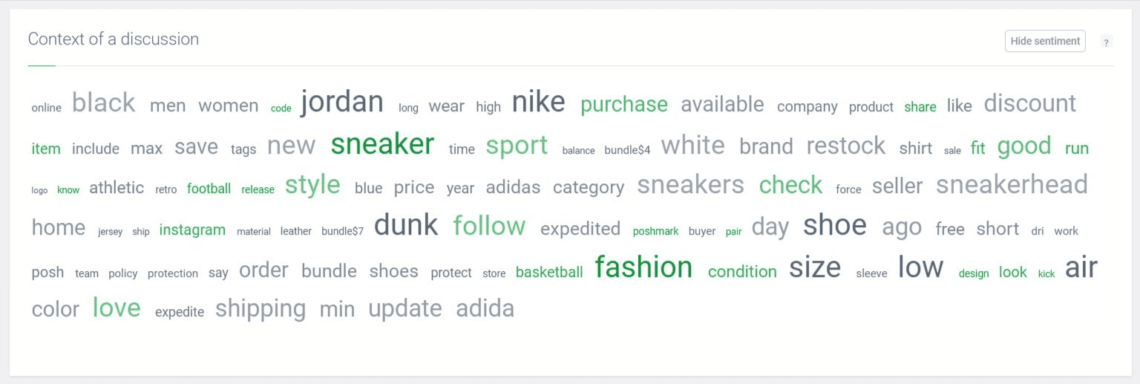
Engaging Customers
By using Twitter listening, companies can engage with their customers in a more meaningful way.
A listening tool allows businesses to respond quickly to customer inquiries or complaints on Twitter and provide timely solutions.
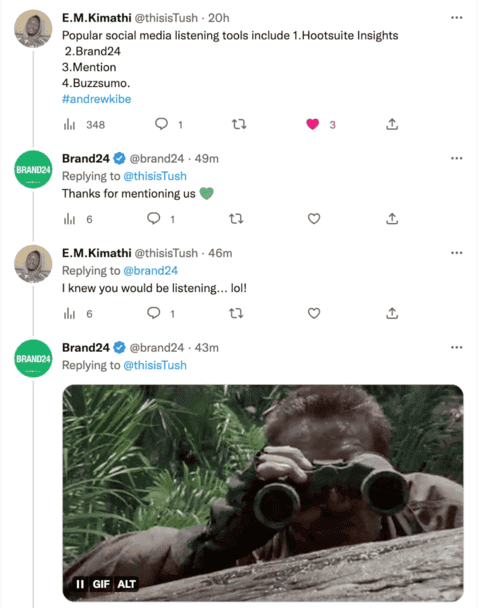
Companies can also use the tool to uncover new opportunities for engagement by tracking what people are saying about them and their competitors. This helps businesses understand how their customers perceive them so they can adjust their products or services accordingly.
Engage in Twitter conversations with your potential clients. Try social listening.
Starting a Twitter Listening Campaign
01 Set Goals
Establishing goals is an important step in any listening campaign on Twitter. This will give you a focus and help to ensure that your efforts are tailored to achieving specific outcomes. Goals should be measurable so that it’s easy to track progress.
Examples of goals for a listening campaign may include increasing brand awareness or engagement, improving customer service, collecting feedback about products or services, and understanding customer sentiment about the brand.
Brand24’s proprietary metrics, such as brand Reputation Score and Presence score, can give you the big picture of your brand online.
02 Keyword Research
Keyword research is another important part of a listening campaign on Twitter.
It involves finding out which terms, phrases, hashtags, and other keywords are most commonly used in conversations related to your brand or topics of interest. This can be done by using monitoring tools that track keyword usage over time.
Once you have identified relevant keywords, you can use them to create searches and filter incoming data so that only the most relevant information is included in your analysis. This will help focus your efforts on what matters most and make it easier to interpret results. Google’s autocomplete is a goldmine of keywords.
Tools like Answer The Public and AlsoAsked can also be a great deal of help here, as they streamline the process. They’re also free!
03 Listen
The third step in starting a listening campaign on Twitter is to begin listening.
This means actively monitoring conversations and interactions related to your brand, products, or services.
Pay attention not only to what users are saying about you, but also to more general topics that are related to your business. Using monitoring tools can help you stay on top of conversations quickly and easily.
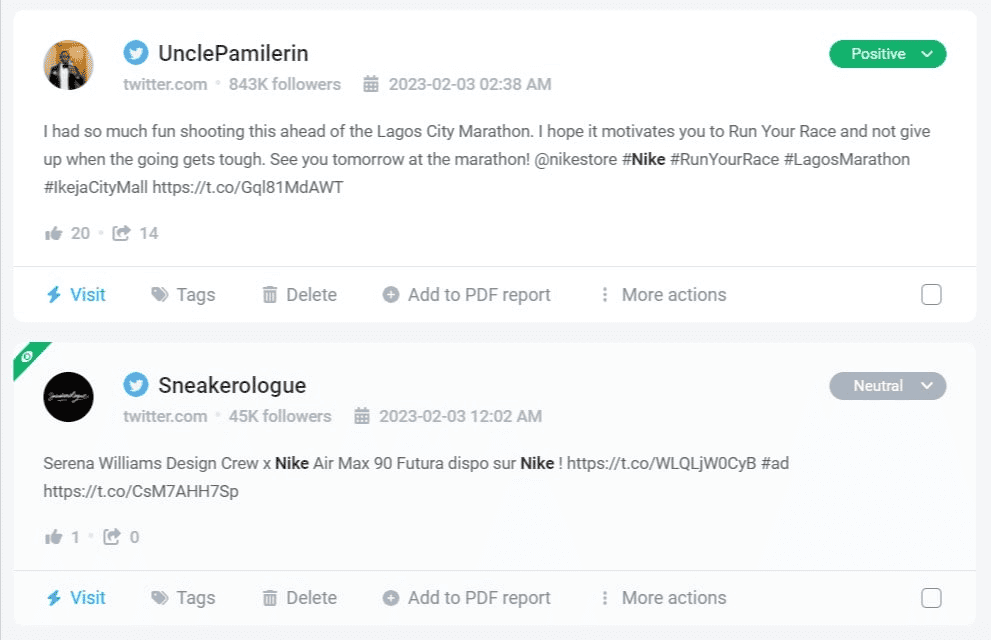
04 Engage
Engaging is the process of responding to conversations about your brand, products, or services.
It involves actively taking part in conversations and providing support, information, or advice when necessary.
Engagement also involves thanking people for their feedback and showing appreciation tousers who share positive experiences with your brand. It’s important to be authentic and genuine when engaging with users so that they feel respected and valued as customers.
An example of an engagement could be responding to a customer’s question about a product or service.
This can involve providing more information, answering questions, and offering helpful advice. It could also mean thanking customers for their feedback and appreciating users who share positive experiences with your brand.
05 Track
Tracking is the process of measuring and monitoring progress toward established goals.
This can involve using Twitter analytics tools to track metrics such as engagement, Twitter sentiment, reach, impressions, and conversions.
Tracking your Twitter account allows you to see how effective your efforts are in achieving the desired outcomes. It can also help to identify areas where more effort may be necessary or reveal potential opportunities for improvement.
The data collected through tracking should be regularly reviewed so that any changes in trends or performance can be identified quickly and addressed accordingly.
06 Analyze
Analyzing is the process of interpreting data and making sense of trends or patterns.
This involves looking at metrics over time to identify any changes or potential opportunities for improvement. It also includes examining conversations related to your brand or products to gain insights into customer sentiment or feedback on specific issues.
Analyzing data provides valuable information that can be used to refine strategies and optimize performance in order to better achieve objectives.
Twitter Listening Tools
1. Brand24
Brand24 is one of the best Twitter monitoring tools that can help businesses build an effective social media strategy.
With Brand24, users can access comprehensive analytics on any keyword or hashtag they wish to monitor to better understand the conversations around their brand.
Users can also adjust settings such as language filters and notifications preferences to customize results according to their needs.
By leveraging the power of Brand24’s, businesses can keep track of trends and customer feedback in real time – allowing them to quickly respond and make informed decisions about their social media presence.
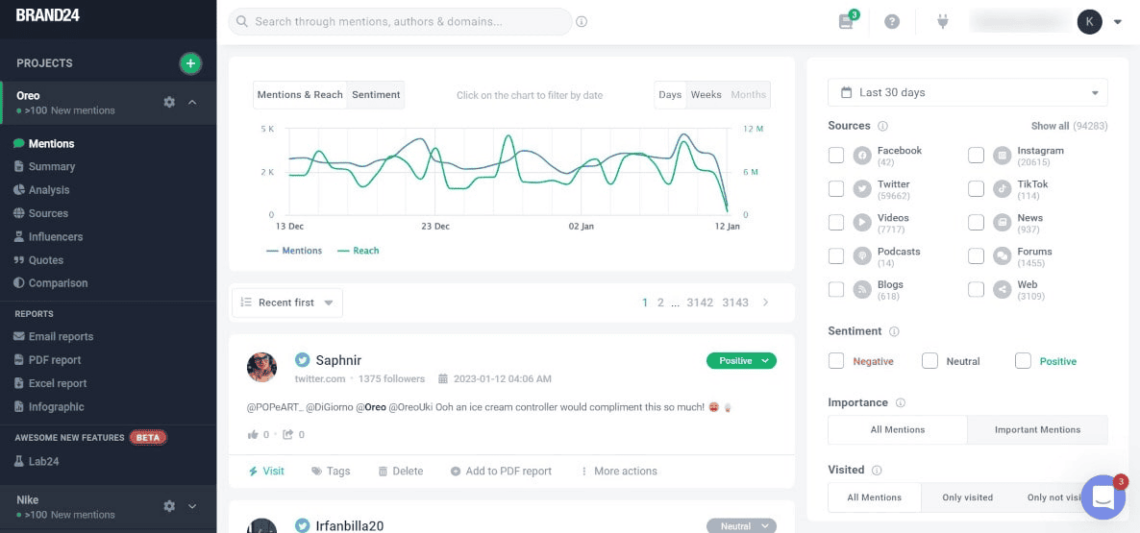
Give social listening a spin. Here’s a free Brand24 trial for you ->
2. Sprout
Sprout Social’s Twitter listening feature enables businesses to track valuable data on brand mentions, giving them insight into what people are saying about them across the web.
With this tool, users can monitor and track keywords, hashtags, and mentions of their brand on Twitter, allowing them to see how people are talking about them online.
This information can be used to improve their marketing strategies, address customer concerns, and respond to any negative sentiment before it spirals out of control.
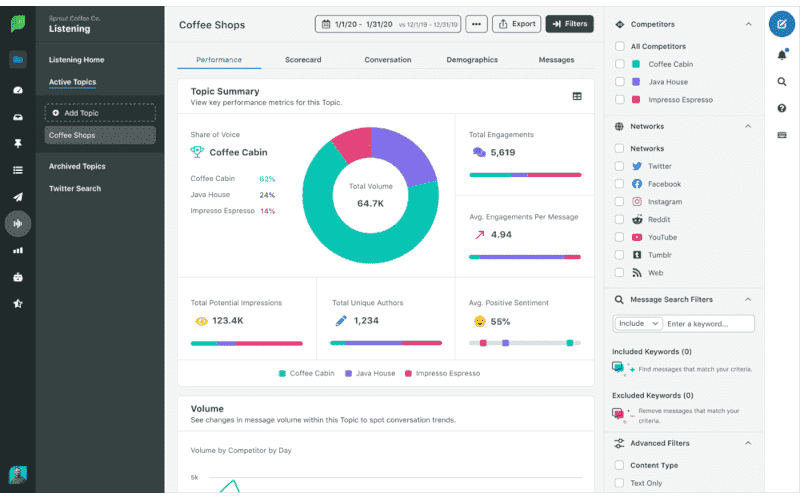
3. TweetDeck
TweetDeck is a Twitter listening tool that enables brands to monitor and engage with conversations across their social media channels.
It allows users to customize the way they view their Twitter activity by creating columns for different topics, hashtags, accounts, or keywords.
This helps them easily track what’s happening on Twitter so they can respond quickly and accurately to help shape their brand image in the most effective way.
With TweetDeck, brands can also schedule tweets ahead of time, manage multiple accounts simultaneously, and use analytics tools to measure how well their posts are doing.
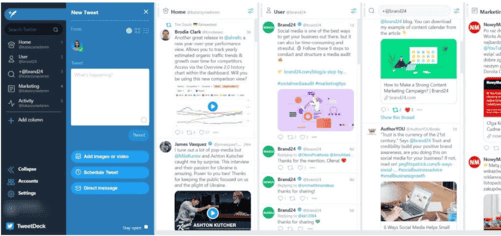
You Have All That Data. What Now?
You’ve come to the right place. We have a quick rundown of what you can do now.
Use Twitter listening data to inform marketing strategies by finding out what users are talking about and responding accordingly.
Using listening data to inform content marketing strategies can be incredibly useful for any organization, from NGOs to SaaS companies.
For example, an NGO may use listening data to discover what people are talking about in relation to their mission and objectives. They might find that there are many conversations about a particular issue relevant to their work, such as poverty or human rights violations. Armed with this information, the NGO can craft targeted campaigns around these topics and engage directly with those having the conversations.
Similarly, a SaaS company can use Twitter listening data to gain insights into customer or brand sentiment regarding its product offerings and compare it against competitors. This type of analysis allows them to identify areas where they need improvement or additional features that customers would like added so they can make changes accordingly.
Additionally, they could also create tailored content surrounding specific topics mentioned in tweets by users, which could help drive engagement and increase brand awareness in the process.
Track competitor’s brand mentions on social networks, look for opportunities to engage customers, and identify potential influencers.
Competitor analysis on social media can be an invaluable tool for any business. It can provide insights into the types of content and activities resonating with their target audience and help identify influencer marketing possibilities.
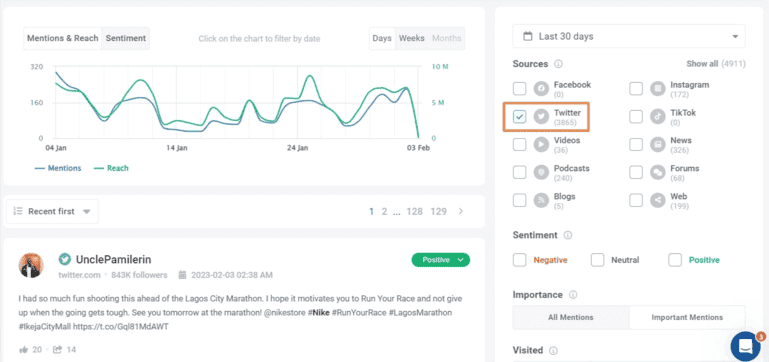
For example, a Non-Governmental Organization (NGO) may look at what topics its competitors have been discussing and promoting over the last few months to better understand which causes they should focus on to reach their own goals.
Similarly, a digital company could track mentions of a competitor on Twitter to stay up-to-date on industry trends and connect with potential customers who have shown interest in similar products or services. They could also pull data for their content strategy.
Monitor customer feedback in order to improve products or services.
Customer feedback can be an invaluable resource for businesses looking to improve products or services.
By setting up a system that monitors customer feedback, companies can make sure that they are always aware of any potential areas in need of improvement and act quickly to address them.
One way this monitoring process could be implemented is through Twitter monitoring, where businesses actively monitor tweets related to their product or service and take note of both positive and negative tweets from customers.
For example, an NGO may set up social listening on Twitter as part of its customer relations strategy with the aim of improving communication between the organization’s staff members and its supporters/donors. The program would track relevant hashtags such as #supportingnonprofits on Twitter in order to identify new donors who might benefit from additional information about how their donations are helping the organization achieve its goals. It could also help detect any issues that current supporters have with donation processes or other aspects related to engaging with the NGO so those issues can be addressed promptly by staff members if necessary.
Similarly, SaaS companies may employ Twitter listening systems in order better understand what features customers find most useful when using their software platform. This kind of data gathered through social media monitoring could then inform decisions around product development efforts going forward based on what users actually want and expect from the product.
Create targeted campaigns based on user interests and engagement levels with your brand.
Using Twitter listening, companies can create targeted campaigns based on user interests and engagement levels with their brand.
For example, an animal welfare organization may use Twitter monitoring to identify users who have shown interest in topics related to animal welfare – such as those tweeting about pet adoption or volunteering at a local shelter. The organization can then target these individuals by creating tailored content aimed at engaging them further with the mission of their cause and how they might be able to contribute.
Similarly, SaaS or other digital companies can also use Twitter listening to better understand user needs and preferences so that they are equipped with the necessary data points needed for effective targeting campaigns.
By monitoring key conversations around relevant topics like software features or customer service inquiries, digital companies gain valuable insights into what potential customers expect from products and services.This enables companiess to build more meaningful connections through personalized messaging that resonates with the members of the target audience.
Identify trends that can be leveraged for new product development or content creation ideas.
One of the most effective ways of leveraging trends for new product development or content creation is through Twitter listening. By tracking conversations on Twitter, companies can gain valuable insights into customer sentiment, industry trends, and emerging opportunities.
A few ideas could be a software-as-a-service (SaaS) company could use Twitter monitoring to identify potential customer needs and develop new products and services to meet those needs.
Similarly, a non-profit organization (NGO) could use Twitter listening to identify potential causes to advocate for and create content around those causes to raise awareness and solicit donations.
Content marketing is an effective way to leverage trends for new product development and content creation. By monitoring conversations on Twitter, companies can inform their content strategies. For example, a SaaS company could create content around customer success stories, customer testimonials, industry trends, and how their products help customers solve their problems.
Similarly, an NGO could create content around their causes and the impact they are making, fundraising opportunities, and how people can get involved and make a difference.
Wrap-up
There’s no denying that Twitter listening is an essential component of any successful social media strategy.
By actively listening to conversations taking place on social media, brands can gain valuable insights into what their customers are thinking and saying. They can then use this information to create more effective marketing campaigns, and build better relationships with their audience.
Read also: A Complete Guide to Twitter Marketing Strategy
FAQ
Does Twitter show what you’re listening to?
No, Twitter does not inherently show what you’re listening to. It’s a social media platform that enables you to share and engage with short messages, images, videos, and more. While you can manually tweet about what you’re listening to, the platform itself does not automatically disclose this information.
However, when we talk about “listening” in the context of social media, we’re often referring to a different concept: social media listening. This involves using social media listening tools like Brand24 to monitor various platforms, including Twitter, for mentions of specific keywords, phrases, sentiments, brands, or topics.
Is TweetDeck a social media listening tool?
Yes, TweetDeck can be considered as a social media listening tool to some extent, but it is more precisely classified as a social media management tool. TweetDeck is a dashboard application primarily designed for managing Twitter accounts and it can be a part of your social listening strategy. It allows users to view multiple timelines in one interface, schedule tweets, and manage multiple Twitter accounts.
What is so unique about Twitter?
Twitter’s uniqueness lies in its emphasis on brief, real-time updates and public conversations. It’s known for its 280-character limit, use of hashtags for categorizing posts, and a user base that includes many influencers. These features allow for lively public discussions and immediate news sharing, making Twitter a vital part of a brand’s social media presence.
Is there a way to listen to Twitter Spaces?
Yes, you can listen to Twitter Spaces, which are live audio conversations hosted on Twitter. To join a Space as a listener, you can tap on the purple bubble at the top of your Twitter timeline whenever it appears. Alternatively, you can click on a link shared with you or tap a Space in a tweet.
However, if you’re asking about using a comprehensive social listening tool to track or analyze conversations happening within Twitter Spaces, this feature is not typically offered. Twitter Spaces are live, spoken conversations, making them more challenging to monitor in the same way as written posts.


